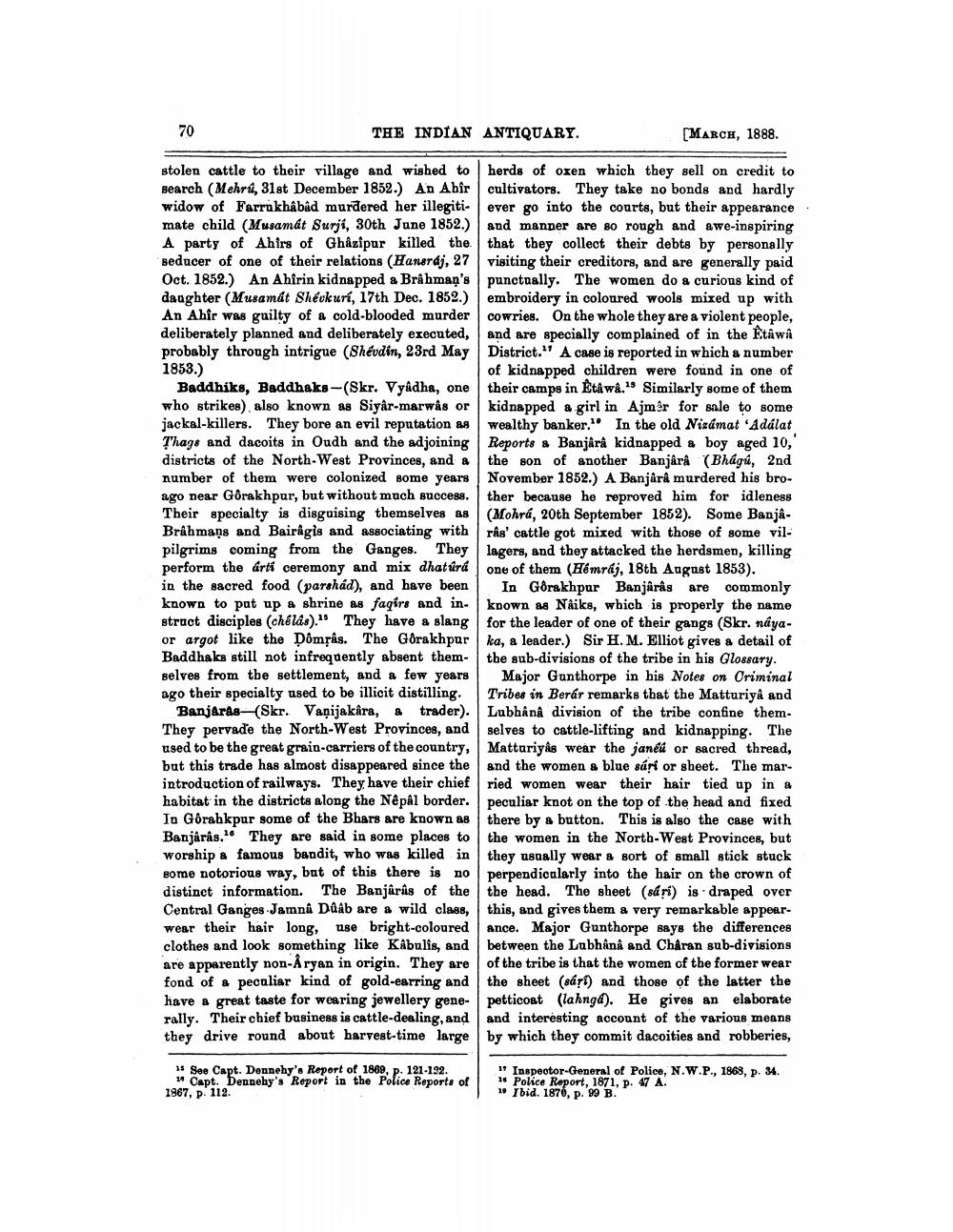________________
THE INDIAN ANTIQUARY.
[MARCH, 1888.
stolen cattle to their village and wished to herds of oxen which they sell on credit to search (Mehrú, 31st December 1852.) An Abîr cultivators. They take no bonds and hardly widow of Farrukhabad murdered her illegiti- ever go into the courts, but their appearance. mate child (Musamat Surji, 30th June 1852.) and manner are so rough and awe-inspiring
A party of Ahirs of Ghazipur killed the that they collect their debts by personally seducer of one of their relations (Hansraj, 27 visiting their creditors, and are generally paid Oct. 1852.) An Ahîrin kidnapped a Brahman's punctually. The women do a curious kind of daughter (Musamat Shevk urí, 17th Dec. 1852.) embroidery in coloured wools mixed up with An Ahir was guilty of a cold blooded murder cowries. On the whole they are a violent people, deliberately planned and deliberately executed, and are specially complained of in the Etawa probably through intrigue (Shevdin, 23rd May | District." A case is reported in which a number 1853.)
of kidnapped children were found in one of Baddhiks. Baddhaks-(Skr. Vyâdha, one their camps in Etawa." Similarly some of them who strikes) also known as Siyâr-marwås or kidnapped a girl in Ajmer for sale to some jackal-killers. They bore an evil reputation 4 | wealthy banker. In the old Nixámat 'Adálat ?'hags and dacoits in Oudh and the adjoining Reports a Banjara kidnapped a boy aged 10, districts of the North-West Provinces, and a the son of another Banjârâ (Bhágú, 2nd number of them were colonized some years November 1852.) A Banjárå murdered his broago near Gorakhpur, but without much success. ther because he reproved him for idleness Their specialty is disguising themselves as (Mohrá, 20th September 1852). Some BanjaBrâhmans and Bairagis and associating with râs' cattle got mixed with those of some vilpilgrims coming from the Ganges. They lagers, and they attacked the herdsmen, killing perform the arti ceremony and mix dhatúrd one of them (Hémráj, 18th August 1853). in the sacred food (parshád), and have been In Görakhpur Banjârâs are commonly known to pat up a shrine as faqirs and in known as Naiks, which is properly the name stract disciples (chélas)." They have a slang for the leader of one of their gangs (Skr. nayaor argot like the Dômrås. The Gorakhpurka, a leader.) Sir H. M. Elliot gives a detail of Baddhaks still not infrequently absent them- the sub-divisions of the tribe in his Glossary. selves from the settlement, and a few years Major Gunthorpe in his Notes on Criminal ago their specialty used to be illicit distilling. Tribes in Berár remarks that the Matturiyâ and
Banjaras-(Skr. Vaņijakâra, trader). Lubhânâ division of the tribe confine themThey pervade the North-West Provinces, and selves to cattle-lifting and kidnapping. The used to be the great grain-carriers of the country, Matturiyâs wear the janed or sacred thread, but this trade has almost disappeared since the and the women a blue sárf or sheet. The marintroduction of railways. They have their chief ried women wear their hair tied up in a habitat in the districts along the Nepal border. peculiar knot on the top of the head and fixed In Görahkpur some of the Bhars are known as there by a button. This is also the case with Banjárás. They are said in some places to the women in the North-West Provinces, but worship a famous bandit, who was killed in they usually wear a sort of small stick stuck some notorious way, but of this there is no perpendicularly into the hair on the crown of distinct information. The Banjârâs of the the head. The sheet (sári) is . draped over Central Ganges Jamnâ Duab are a wild class, this, and gives them a very remarkable appearwear their hair long, use bright-coloured ance. Major Gunthorpe says the differences clothes and look something like Kabulis, and between the Lubhânâ and Charan sub-divisions are apparently non-Aryan in origin. They are of the tribe is that the women of the former wear fond of a peculiar kind of gold-earring and the sheet (sárt) and those of the latter the have a great taste for wearing jewellery gene- petticoat (lahngd). He gives an elaborate rally. Their chief business is cattle-dealing, and and interesting account of the various means they drive round about harvest-time large by which they commit dacoities and robberies,
* See Capt. Dennehy's Report of 1869, p. 121-132.
* Capt. Dennehy's Report in the Police Reports of 1967, p. 112
" Inspector-General of Police, N.W.P., 1868, p. 34.
Police Report, 1871, p. 47 A. 19 Ibid. 1870, p. 99 B.




